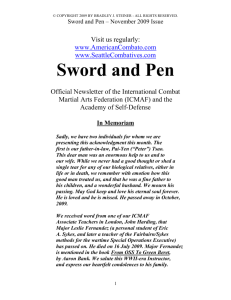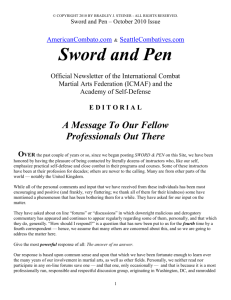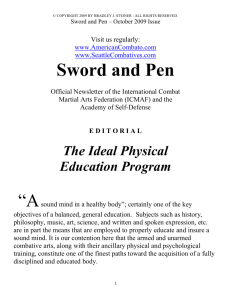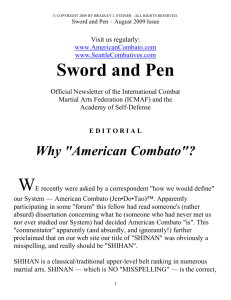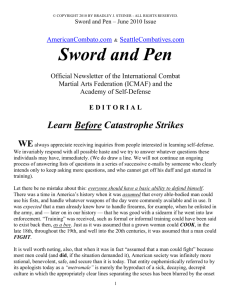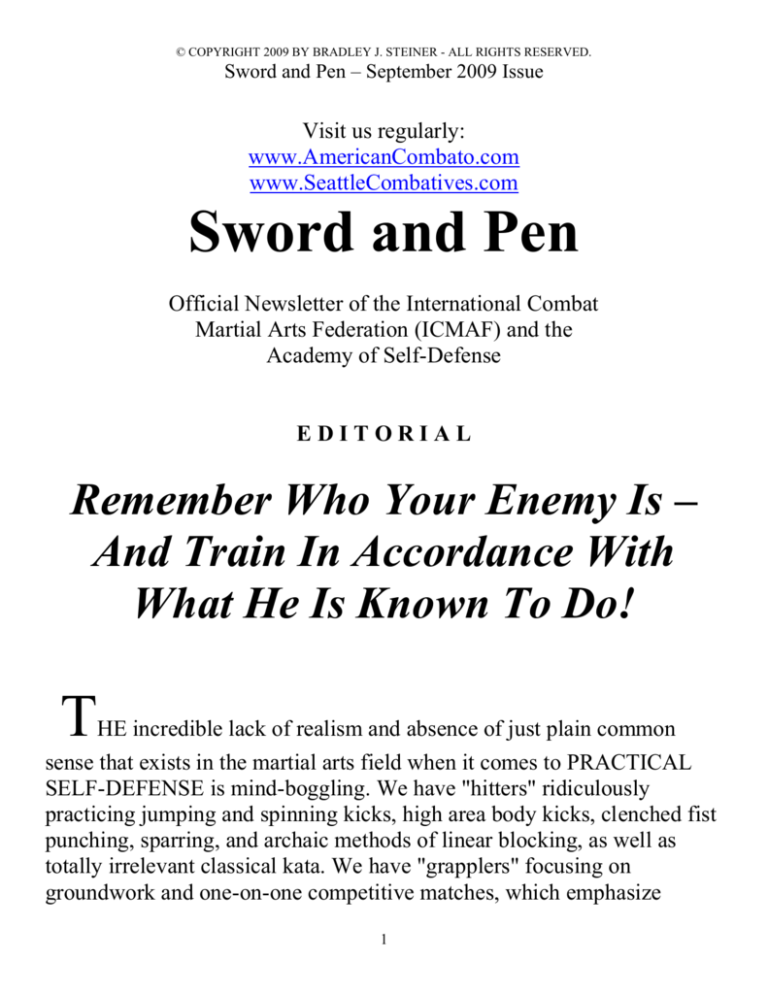
© COPYRIGHT 2009 BY BRADLEY J. STEINER - ALL RIGHTS RESERVED.
Sword and Pen – September 2009 Issue
Visit us regularly:
www.AmericanCombato.com
www.SeattleCombatives.com
Sword and Pen
Official Newsletter of the International Combat
Martial Arts Federation (ICMAF) and the
Academy of Self-Defense
EDITORIAL
Remember Who Your Enemy Is –
And Train In Accordance With
What He Is Known To Do!
T
HE incredible lack of realism and absence of just plain common
sense that exists in the martial arts field when it comes to PRACTICAL
SELF-DEFENSE is mind-boggling. We have "hitters" ridiculously
practicing jumping and spinning kicks, high area body kicks, clenched fist
punching, sparring, and archaic methods of linear blocking, as well as
totally irrelevant classical kata. We have "grapplers" focusing on
groundwork and one-on-one competitive matches, which emphasize
1
© COPYRIGHT 2009 BY BRADLEY J. STEINER - ALL RIGHTS RESERVED.
Sword and Pen – September 2009 Issue
"submission" and "pinning" actions, and then we have hybrids(!) — i.e.
the inevitable compromisers who combine clenched fist pummeling with
groundwork (laced, of course, with a sprinkling of elbowing, throwing,
and one or two other tidbits). And of course there is not a single thing
wrong with any of these things, until or unless you specify "PRACTICAL
APPLICATION AND REAL WORLD PERSONAL DEFENSE" as your
training objective. That changes everything, immediately.
Yes, competition fighters are genuinely tough fellows, and yes —
certainly — many of them can defend themselves in actual situations. No
doubt about it. However, the same can be said of boxers, wrestlers, judo
men, kick boxers, and so on. None of which demonstrates anything at all
of relevance insofar as establishing that which is required in HAND-TOHAND COMBAT and EMERGENCY SELF-DEFENSE SITUATIONS,
when the entire reason and purpose is preparing for combat and selfdefense as opposed to competition.
To use an analogy with firearms:
An experienced and competent big game hunter can certainly employ his
bolt action .378 weatherby magnum rifle (an upgrade of the brutal .375) in
a battlefield environment, and perhaps even be successful in dropping an
attacking soldier or two. But that does not make the .378 round, the bolt
action rifle that fires it, or the marksman/hunter who employs this
awesome combination, any kind of "model of that which is best suited to"
REAL MILITARY BATTLEFIELD ENGAGEMENTS. A .308 battle
rifle — designed, intended, and constructed specifically for warfighting —
would be the intelligent man's choice, for going to war. And, similarly, the
type and style of firing that the big game hunter excels in when dropping
African big game, and which — admittedly — he may be able to apply to
2
© COPYRIGHT 2009 BY BRADLEY J. STEINER - ALL RIGHTS RESERVED.
Sword and Pen – September 2009 Issue
antipersonnel engagements, is hardly the type and style of rifle shooting
appropriate to combat.
Self-defense and hand-to-hand combat is a subject and study unto itself.
Many in the martial arts do not (or do want to) realize this, and so they
continually equate that which is sporting, aesthetic, classical, or theatrical
with that which works in combat.
Self-defense is war. It is a microcosmic war between individuals, instead
of between nations; but it is war, nonetheless. Where and when an activity
is presented as "self-defense" in a non-warlike manner, then the term selfdefense becomes a misnomer. It is self-defense when one individual is set
upon by another, and when force or the threat of force is utilized for the
personal satisfaction, gratification, or gain of the attacker against an
innocent victim.
• Being jumped in the street by one or more savages is a self-defense
situation
• Being seized suddenly from behind is a self-defense situation
• Being attacked by someone using a knife, club, firearm, or other handheld weapon (or implement which he employs as a weapon) is a selfdefense situation
• Being confronted by a punk, troublemaker, or bully whose intention it is
to terrorize, push-around, beat up, intimidate or otherwise torment you is a
self-defense situation
3
© COPYRIGHT 2009 BY BRADLEY J. STEINER - ALL RIGHTS RESERVED.
Sword and Pen – September 2009 Issue
• Being suddenly aware that your home is being broken into — invaded —
by marauding scum is a self-defense situation
• Being set upon by a deranged individual who proceeds, suddenly and
without provocation, to violently assault you is a self-defense situation
• Being targeted for a kidnapping is a self-defense situation
• Being with a family member or other loved one and witnessing their
being attacked is a self-defense situation
• Being confronted by some lout who proceeds for whatever reason to
become physically harassing and abusive — pushing, leaning on, or
shoving you — is a self-defense situation
• Being approached by someone who unlawfully blocks your path and
refuses to allow you to leave the area is a self-defense situation
• Being run off the road and then attacked by a careful of human debris
who are "out for kicks" is a self-defense situation
• Being threatened with bodily harm and observing the threatener reach for
what you are certain is a concealed weapon is a self-defense situation
• Being set upon by one or more punks while you are riding on a public
conveyance is a self-defense situation
• Being the victim of a carjacking in which you as well as your vehicle is
the criminal's objective, is a self-defense situation
4
© COPYRIGHT 2009 BY BRADLEY J. STEINER - ALL RIGHTS RESERVED.
Sword and Pen – September 2009 Issue
• Being the intended target of forcible rape constitutes a self-defense
situation
Need we continue?
• Agreeing to a physical contest with someone who wishes to participate,
and where there are rules and regulations of any kind — plus a referee —
is NOT a self-defense situation
• Participating in a judo, boxing, karate, wrestling, kick boxing, or other
competition match or event is NOT a self-defense situation
• Mindlessly agreeing to "step outside" (or remain inside!) and fight with
someone is NOT a self-defense situation
If it is your purpose to prepare for the realities attendant the unfortunate
predicament of finding yourself obliged to defend against serious criminal
violence, then look to how violent offenders attack. Analyze their modus
operandi. Over the last several hundred years it has been so well
documented that we can tell with near certainty how attacks will occur.
Certainly, every situation is "different"; but in a very real and provable
sense, ALL SITUATIONS IN WHICH VIOLENCE IS DIRECTED
AGAINST VICTIMS, ARE ALSO — PREDICTABLY — THE SAME.
The types of situations in which violence occurs and the manner in which
offenders move against their target-victims is known, is ascertainable, and
is quantifiable.
Situational awareness (alertness) is of course rule number one for those
wishing to be prepared for an emergency. Agreed-upon contests of all
5
© COPYRIGHT 2009 BY BRADLEY J. STEINER - ALL RIGHTS RESERVED.
Sword and Pen – September 2009 Issue
types begin at appointed times. Attacks may begin at any time. And
anywhere.
Once having determined that one has been targeted for a hostile approach
by one or more others who appear to be intent upon the use of force,
escape and avoidance — if possible, without incurring undo risk to
yourself or to someone else — is the all round best course of action. When
escape and avoidance is not possible, then FEROCIOUS PREEMPTIVE
ATTACK — relentless, "ferocious, preemptive attack"! — is the wisest
course. Seize the initiative and go after your attackers! Violently,
mercilessly, viciously, and with every ounce of strength, resolve, fury, and
determination you can muster.
Such techniques as are popularly labeled "self-defense techniques" are
really the least desirable techniques upon which to rely in an emergency,
because these techniques are applied against a full blown attack, and only
after the attack has gotten fully underway. These techniques, providing
that they are of real quality and not mere "artistic exercises", are
necessary in a comprehensive program, of course — but only as a backup
to techniques of PREEMPTION.
We train in American Combato then, to react to violence in one of three
ways:
We AVOID it (the best of all possible options)
We PREEMPT the assailant (best option when avoidance is impossible)
We COUNTERATTACK the attacker's action (the least desirable option,
but nevertheless one we all must be prepared to employ)
6
© COPYRIGHT 2009 BY BRADLEY J. STEINER - ALL RIGHTS RESERVED.
Sword and Pen – September 2009 Issue
Taking a specific, concrete example:
If you notice that a suspicious. individual is walking toward you aa you
proceed down the street your wisest course of action is to unostentatiously
alter your own route and cross the street. AVOIDANCE.
If, as you cross the street, you observe that this individual has cued in on
you and has crossed the street also, heading in your direction, you shift
immediately to "condition orange". As the individual confronts you, you
are in your ready position, distanced properly, and fully prepared for
trouble (without revealing in any way that this is the case).
If the individual suddenly commences an aggressive action, you
immediately attack. You lash out with a kick and break his leg, thrust a
sharp fingertips attack to his eyes, or otherwise drive into him, preempting
his onslaught. PREEMPTION.
Only in an instance when you were too carelessly oblivious to the
stranger's approach, would you forego avoidance and continue to walk
into a questionable situation. And, only if you were perhaps in "condition
white" would the individual whose approach you had eventually to deal
with as an attack need to be "countered" — since only because you blew
the "avoidance" and the "preemption" options did it become necessary to
handle his full blown attack with a reactive, "counterattacking" technique.
The important thing of course is that we train so as to be able to do that
which we must (ie avoid, preempt, or counter) in suitably realistic
contexts.
7
© COPYRIGHT 2009 BY BRADLEY J. STEINER - ALL RIGHTS RESERVED.
Sword and Pen – September 2009 Issue
No one "squares off" in a self-defense situation or "agrees to fight". A
self-defense emergency is like an ASSASSINATION attempt, not like a
"contest". Prepare for it accordingly.
Many, many years ago (or at least it seems like many, many years ago!)
we learned something very valuable from one of our beloved teachers:
Charlie Nelson. We learned to clip and to study all news stories from local
and even out-of-town newspapers regarding violent crimes. These stories,
and not ridiculous attempts to master "contest strategies" and "winning
actions" for competition will reveal precisely that which one is up against
when one wishes to prepare for real world self-defense.
There is also personal experience, if one has been unfortunate enough to
have amassed any.
There is also speaking with seasoned street cops.
There is also speaking with psychiatrists and psychologists who have
specialized in studying criminal violence.
There is also interviewing and garnering information from military combat
veterans (Note: this does NOT mean anyone who has served in the
military. It means those who have been in hand-to-hand combat and who
know — firsthand — what it involves.)
And finally there is the individual who has been victimized and who has
been fortunate enough to survive the incident.
All of the foregoing is highly recommended. We have unceasingly been
utilizing these methods and means of acquiring reliable knowledge about
8
© COPYRIGHT 2009 BY BRADLEY J. STEINER - ALL RIGHTS RESERVED.
Sword and Pen – September 2009 Issue
close combat and self-defense since the late 1960's. And we continue to
use these methods, whenever and wherever we are able, as frequently as
we can.
We respectfully suggest: If you are after really reliable and practical
doctrine regarding close combat and personal defense, you follow our
example and our advice.
In preparing for survival one cannot be too "realistic".
Bradley J. Steiner
-----------
Two Unpleasant Facts
THE first is that most violent attacks today involve multiple assailants.
The second is that most violent attacks also involve assailants who are
armed.
The above (for anyone having a problem with reading comprehension)
does not mean that "all" attacks or that "every" attack involves multiple
assailants and weapons. There are still plenty of instances when punks,
bullies, and assorted other scum who like to make trouble, "go it alone and
unarmed" and simply attempt to gratify their despicably insane desires and
drives by targeting some soul whom they feel that they can push around,
injure, humiliate, beat up, rob, or even kill without the assistance of fellow
bacteria to back up their efforts. However, THE MAJORITY OF
UNAVOIDABLE, VIOLENT AND DANGEROUS PHYSICAL
9
© COPYRIGHT 2009 BY BRADLEY J. STEINER - ALL RIGHTS RESERVED.
Sword and Pen – September 2009 Issue
ATTACKS THAT OCCUR ON THE MEAN STREETS AND IN THE
HOMES OF URBAN AND SUBURBAN AMERICA TODAY involve
multiple and/or armed scum.
The implications of these two facts are profound. They at once tell us
volumes about the state of moral and cultural decrepitude that our society
has degenerated to, while at the same time teaching us some valuable
lessons regarding THAT WHICH WE NEED TO DO IN ORDER TO BE
PREPARED TO DEFEND OURSELVES.
Since even the worthless dailies and the carefully prepared and doctored
evening "news" reports on TV have (unwittingly) presented all that any
intelligent and objective individual might require in the way of evidence
that Western culture is FINISHED, we will not dwell on this fact. Besides,
it makes us nauseous even to think about it.
We'll shift right to the matter of preparing for the possibility of being
forced to defend against more than a single adversary who attacks us,
and/or for the possibility (read: probability) of having to contend with
WEAPONS during any physical encounter.
What — really — must we understand about these types of situations, and
what must we do to be reasonably sure that, if one of them ever comes to
us, we stand a good chance of surviving and prevailing over the odds?
The first thing to understand is that life-threatening physical attack
situations amount to situations of WAR. We are not "competing" when we
undertake to fight a war — we are battling for survival! There are no rules
in war, save one: WIN! The very concept of ethics, fairness,
10
© COPYRIGHT 2009 BY BRADLEY J. STEINER - ALL RIGHTS RESERVED.
Sword and Pen – September 2009 Issue
sportsmanship, or even decency, is suspended "for the duration". And
when the "war" is a self-defense emergency that has been foisted upon an
unfortunate victim, IT IS THE ATTACKER(S) WHO BEARS FULL
RESPONSIBILITY FOR WHAT OCCURS, AND IT IS THE
ATTACKER WHO HAS CHOSEN TO SUSPEND ETHICS, FAIRNESS,
SPORTSMANSHIP, AND DECENCY, BY VIRTUE OF THAT WHICH
HE HAS CHOSEN TO DO. If a defender is to have a chance to prevail in
such an awful situation, he cannot and must not be burdened with
concerns for such humane considerations that his attacker(s) has
disregarded.
The second thing to understand about these situations is that THEY ARE
ALWAYS LIFE-THREATENING. Whether multiple/and/or armed
assailants are youngsters or older individuals, and regardless of their
gender the threat that they pose is a lethal one. Thus, the reaction that a
defender is not only justified in generating, but also URGED TO APPLY
WITHOUT HESITATION, is deadly force.
The third lesson we must learn is that tactics must be suitable to the
emergency. "Training for self-defense" by restricting oneself to one-onone type predicaments, or to the assumption that no weapons will be
involved (unless we SEE a weapon) is ridiculous. The proper tactical
imperative for the student of close combat and self-defense is to train in
the skills that he is acquiring by assuming that — even when he is not
initially aware of the fact — the individual whom he initially confronts has
assistance, and is armed. Statistics conform the validity of such an
assumption.
The fourth lesson that offers is that those who train for self-defense must
train in techniques that enable them to — a) Inflict immediate and
11
© COPYRIGHT 2009 BY BRADLEY J. STEINER - ALL RIGHTS RESERVED.
Sword and Pen – September 2009 Issue
grievous injury, without tying oneself up with any single, individual
adversary, and b) React under any conditions, anywhere, with skills that
are reliably simple and that have been retained without any need for
excessive practice. "Training for a contest" is a short-term, young man;s
game. Training for self-defense is a LIFETIME PURSUIT. If the skills
with which an individual trains are not retainable and DOABLE when he
is in hs 70's and 80's, then what possible value can they have for real
world self-defense? Remember: One becomes a more attractive target for
human scum when one becomes old; one cannot claim that one is "retired
from competition" and expect a trio of armed home invaders or street
bacteria to retreat!
The fifth critical thing to learn from looking at the facts is that ONE
MUST INCLUDE MODERN WEAPONS IN ONE'S TRAINING AND
STUDY OF SELF-PROTECTION. Criminals carry and use firearms,
knives, and other deadly weapons. There is no reason on earth why decent
people should not avail themselves of such weapons, also — and make
themselves MUCH BETTER SKILLED AND DANGEROUS WITH
THOSE WEAPONS THAN ARE THE SCUM WHO WOULD PREY
UPON THEM.
In our advocacy of the attitude, skills, armament, and tactical
considerations that we have presented we wish to make it clear that in no
sense do we condone, advocate, or in any manner sanction the breaking of
any laws. We are simply trying to provide a wake up call to those whose
sense of practicality may have been less than desirable in their efforts to
prepare for actual, real world emergencies.
We have never believed that there was any reason why decent human
beings should not avail themselves of the fullest measure of readiness for
12
© COPYRIGHT 2009 BY BRADLEY J. STEINER - ALL RIGHTS RESERVED.
Sword and Pen – September 2009 Issue
dealing with any who might attempt to violate them. And in today's sick
and violent world, "those who would attempt to violate them" generally
move in packs (like hyena), and carry weapons to assist their evil purpose.
The Value Of Blows To The Head
WHILE it is no secret that clenched fist punching to the bony facial and
head area will often result in more serious injuries to the one who delivers
such punches than they inflict upon the recipient, the student of close
combat must understand that not only are blows to the head critically
important in real hand-to-hand engagements, but also that there are
powerful and reliable methods of delivering such blows that — although
banned in competition — are pure gold for emergency application when
one is playing marbles "for keeps!
Blows to the head are potentially very dangerous. They are also
INSTANTLY DECISIVE, which makes them outstanding techniques to
employ in an emergency. When the head is struck powerfully there is
extreme shock to the brain. And if the head is struck ferociously in one
direction and then in the opposite direction the result will almost
invariably be a KNOCKOUT, since concussion is the likely outcome. The
knockout results from tissue being torn inside the head as the brain is
shaken violently within the skull from the successive hits. This accounts
for the famous "one two" knockout sequence so often referred to in
boxing: A left jab is snapped smartly into the opponent's face, and then a
powerful straight right completes the job!The only problem with this
excellent sequence is that it is a boxing sequence. The clenched fists sans
gloves are not good for striking blows to the head (as stated earlier)
outside the ring.
13
© COPYRIGHT 2009 BY BRADLEY J. STEINER - ALL RIGHTS RESERVED.
Sword and Pen – September 2009 Issue
Besides, it can take six to eight months for a novice to train to the point
where he can reasonably expect to deliver sufficiently accurate and
forceful clenched fist punches to effect a reliable "one-two" sequence.
NOT SO with the following blows:—
• Edge of the hand
• Heel of the hand
• Hammerfist smash
• Elbow smash
• Head butt
Those blows — normally banned (and quite properly so!) from full
contact application to the facial/head area in sporting contests, are perfect
for employment against a violent attacker, when the "prize" is
SURVIVAL.
No one struck viciously and solidly with any one of those five blows will
fail to be at the very least disoriented long enough for a second blow —
executed with the same or with one of the other natural weapons — that
smashes his head powerfully in the opposite direction of the original blow.
Here are some suggested combinations to work on:—
a) Snap a speedy leading edge-of-the-hand blow to the opponent's face,
then drive your body forward as the chopping hand returns and smash a
forward elbow blow across the opponent's temple.
14
© COPYRIGHT 2009 BY BRADLEY J. STEINER - ALL RIGHTS RESERVED.
Sword and Pen – September 2009 Issue
b) Leading hand delivers an edge-of-the-hand blow, then step in and drive
a chinjab smash (heel-of-the-hand blow) upward under the opponent's jaw
with your rearmost hand.
c) Chinjab smash rapidly — alternating hands — driving two blows, one
into each side of the opponent's head, in rapid succession.
d) Execute a sharp, untelegraphed vertical hammerfist smash to the
opponent's temple or jaw hinge area with your rearmost hand. Followup
instantly after impact by slamming a lead arm elbow smash into the
opponent's head.
e) Head butt your opponent smartly as he moves in close to you (or you to
him), then drive a hooking heel of the hand blow using your foremost
hand into his temple or jaw hinge.
f) Deliver a chinjab smash using your rearmost hand to the opponent's jaw,
then followup with a lead arm elbow smash across the opponent's temple
or jaw hinge.
CAUTION!: The foregoing sequences are extremely dangerous and can
result in serious injury. They are NOT to be practiced with contact to a
live training partner, and they are NEVER to be used against anyone,
except in a case where self-defense action is unavoidable in order to
prevent grievous injury from an attacker. Work the blows in the air, on
dummies, on a heavy bag, or on some other striking apparatus.
When you train, observe the following points:
15
© COPYRIGHT 2009 BY BRADLEY J. STEINER - ALL RIGHTS RESERVED.
Sword and Pen – September 2009 Issue
• Always launch your attacks by surprise. Make no "cocking" or other
telegraphing movements — just HIT!
• Get your entire body into the blows by utilizing waist-hip turn and
driving forward into the attack.
• Although the sequence will almost certainly drop your man if successful,
be prepared to followup relentlessly — just in case.
• Give lots of thought to all of the situations in which the sequences may
be applied.
• Develop other sequences, according to your inclinations, experiences,
and personal preferences.
• Become a "HEADHUNTER"! Go after your attacker's head with
powerful barrages of successive unarmed combat strikes whenever you are
in danger, and attacking in this manner appears to be suited to the
situation!
• Never forget that the purpose of these specific combinations is to JAR
and SNAP the opponent's head viciously in one direction and then
suddenly in another — with the aim of causing concussion.
REREAD THE "CAUTION" AND PAY ATTENTION TO ITS
MESSAGE! We do not assume any responsibility for your use or misuse
of this or any other information imparted here or elsewhere. Be a
responsible, law-abiding, non-troublesome and peaceful person. Use these
types of actions ONLY in legitimate self-defense!
16
© COPYRIGHT 2009 BY BRADLEY J. STEINER - ALL RIGHTS RESERVED.
Sword and Pen – September 2009 Issue
"Suppose He ‘Squares Off'
In A Fighting Stance?"
THE question sometimes arises concerning what to do and how to react
when a troublemaker whom one is facing in a correct ready position that
one has assumed, abruptly shifts from a belligerent or verbally threatening
demeanor to an actual fighting stance. Remember: competition is
completely unrelated to combat. And sparring in any form is wholly
unrelated to "self-defense". Thus, as a properly trained student of selfdefense you will take NO OVERT "FIGHTING STANCE". Your
assumption of that which we teach as a "RELAXED-READY STANCE"
at the outset of an approach completely prepares you, should things turn
nasty. And of course if you are simply attacked suddenly with no warning
whatever, you must simply go into attack mode, and if you have not been
rendered unconscious or disabled by the surprise attack, YOU BECOME
THE AGGRESSOR. Hardly any point in considering a fighting stance if
you are unaware of anything or anyone whom you are to "face" in the
"stance" in the first place, is there?
But here you are, in the following situation:
A presumed troublemaker (punk, toughguy, piece of street scum, bully,
etc.) is confronting you. Thus far he has made no indication of physical
aggression, and so you are simply in MENTAL CONDITION ORANGE,
distanced outside of arm's length if at all possible, and off-angled with
your hands non aggressively held at about sternum level. Your eyes rest
on his face, thus permitting you — via peripheral vision — to pick up
every nuance of his movement.
17
© COPYRIGHT 2009 BY BRADLEY J. STEINER - ALL RIGHTS RESERVED.
Sword and Pen – September 2009 Issue
Suddenly, with no real warning save the verbally offensive tirade that has
thus far been hurled at you, this bacteria draws its hands into fists and
positions itself obviously for fighting.
What action ought properly to be taken at this point?
Very simple: ATTACK VICIOUSLY AND WITH EVERY OUNCE OF
YOUR SPEED AND POWER! DRIVE INTO AND THROUGH THIS
AGGRESSOR, TAKING HIS ASSUMPTION OF A FIGHTING
STANCE TO BE THE FIRST MOVE OF AN OVERT PHYSICAL
ATTACK, WHICH IT IS!
THE PURPOSE OF BEING POSITIONED IN A RELAXED-READY
STANCE IS TO PRIME YOU — JUST IN CASE — AND MAKE ANY
FURTHER PREPARATORY ACTION, SHOULD WHOEVER IS
CONFRONTING YOU INITIATE PHYSICAL FORCE, BEFORE
MOVING IN AND TOTALLY NEUTRALIZING YOUR FOE.
When an individual has an apparent ability to harm you, a clear
opportunity to harm you (due to his position and proximity to you, etc.),
and what any reasonable person would interpret as an intention to harm
you, you are completely justified in taking preemptive, decisively
aggressive action, as far as we — as a lay person — understand the law to
be. As the "assault" begins, so may your counterattacking action. You
need not wait for the actual "battery" (i.e. blows or other force reigned
upon your person) before you take action. Being in obvious, imminent
physical danger is sufficient.
A "fighting stance" per se is of course appropriate to, and invariably
assumed in, all contests and competitive events, since the participants
18
© COPYRIGHT 2009 BY BRADLEY J. STEINER - ALL RIGHTS RESERVED.
Sword and Pen – September 2009 Issue
begin as equals, and must forego real combat tactics. The victim of an
attack (ie YOU, perhaps) has no agreement with his tormentor, and would
be truly idiotic to grant "terms of engagement" to some low-life piece of
violent filth whose intention it is to victimize him!
Never mind how some gutter animal "wishes" to fight you. If he is
attacking and you are defending, there is nothing sporting about the thing,
whatever. JUST DROP HIM WHERE HE STANDS. And use the foulest,
dirtiest, most viciously ruthless and destructive UNsporting actions of
which you are capable.
That's real self-defense.
Note A: In fact you must train and prepare PRIMARILY for the type of
attacker who does attempt to launch a surprise attack, and take you
completely unaware. We have gone into this detail regarding what to do
when a scumbag assumes a fighting stance only because it is apparently a
concern of many students.
Note B" One of the simplest ways to react in the situation discussed here
is to lash out with a side kick and break the punk's knee.
COMBAT EXPERIENCE
IN both armed and unarmed martial activities two completely different
orientations exist:
1. SPORT
— and — 2. COMBAT
19
© COPYRIGHT 2009 BY BRADLEY J. STEINER - ALL RIGHTS RESERVED.
Sword and Pen – September 2009 Issue
Neither one is per se "better than" the other, but each is distinct and very
different from the other, and it is the mark of one who lacks understanding
of either to deny this.
Sport has always been more popular than combat training, and probably
will always remain so. This is, we suspect, because sport is enjoyable for
most people. Sport offers excitement without posing much if any real
danger, and it is controllable as well as being, to a certain degree,
predictable. Sport is ongoing, safe, interesting, recreational, healthful, and
fun. Combat, on the other hand, is undesirable, astonishingly sudden,
short-lived, very dangerous, never without unpleasant consequences, and
all-too-often quite permanent in its results. Combat also has extremely
serious moral and legal implications.
There is no round two in combat. Nor is there a next time (i.e. a rematch);
it is now or never — EVERY TIME.
The other day we were reflecting at leisure upon something that we found
fascinating. That is, the two different venues of COMBAT HANDGUN
technique and UNARMED COMBAT owe their respective "wrong
turnoffs" recently (insofar as close combat is concerned), to the
unfortunate failure in both instances of enthusiasts and "experts" to look to
COMBAT EXPERIENCE, as opposed to COMPETITION EXPERIENCE
for validation of combat and personal defense skills and doctrine.
Prior to the advent of the so-called "new technique" of the pistol (a
technique developed and "proven" 100% in the competitive arena, please
note), it had been understood that POINT SHOOTING (which had been
validated and established beyond doubt or any nuance of question as The
Right Way to employ a handgun in combat) was in fact "combat handgun
20
© COPYRIGHT 2009 BY BRADLEY J. STEINER - ALL RIGHTS RESERVED.
Sword and Pen – September 2009 Issue
shooting". Why? Because decades of real world, actual combat shooting
EXPERIENCE in peacetime and during wartime, had proven it to be so.
Prior to the advent of the so-called "challenge events" in martial arts, and
the foisting upon the public the observable phenomenon of grappling's
superiority to hitting IN REGULATED SPORTING CONTESTS
(something that tests in American universities and colleges had already
proven years before the martial arts field was infected by the misleading
spinoff that has since led to today's disgraceful chip-on-the-shoulderism,
and "I'm a tougher-dude-than-you-are-itis") IT WAS UNDERSTOOD that
blows were preferable in real battle. Why? Because COMBAT
EXPERIENCE in peace and war had incontrovertibly demonstrated that
FACT.
And in fact real combat experts — who were trained in grappling —
understood the matter clearly. Fairbairn, O'Neill, Brown, Begala, and
others — all of whom had been primarily and predominantly trained and
experienced in grappling and in groundwork, tossed all of that and
INSISTED UPON BLOWS (GOUGES, KICKS, JABS, ETC.) as the core
of hand-to-hand training, when preparing men for war.
It does not surprise us that the majority of people who do not want to
accept the truth simply do not accept it. This has been the way, throughout
human history. Such individuals are not our concern.
We speak and have always spoken only to those who think and whose
ultimate reference when deciding upon any issue is REALITY.
21
© COPYRIGHT 2009 BY BRADLEY J. STEINER - ALL RIGHTS RESERVED.
Sword and Pen – September 2009 Issue
The reality, and the truth, is that only actual combat experience, with or
without weapons, can ultimately reveal what does and does not work IN
ACTUAL COMBAT.
In both combat use of the handgun and in unarmed and hand-to-hand
combat, those of us who are professionals in this field HAVE looked to
the realities of combat experience and we base all that we teach and do on
what those realities demand.
Remember that this is not an attack on sporting competition in whatever
form or version anyone may enjoy participating. We are merely
establishing that sport and combat are different; and it is extremely
dangerous for those seeking personal defense skills or hand-to-hand
combat skills for war, to confuse the issue and fail to recognize this
FACT.
Another thing, which we leave our readers with for the purpose of clarity:
In no dictionary or thesaurus that we have ever seen is the word
"DIFFERENT" indicated as a synonym for "BETTER". We, and others
like us who are in this field professionally, have never made the claim, and
have never felt, that close combat and self-defense training is "better" than
competition training. We only maintain — in fact, insist — that the two
venues are different.
And it is reality and combat experience that has led us to our conclusion.
We respectfully suggest that these are two VERY important
considerations when determining how best to train for self-defense. That
is, they are very important considerations if you are using your MIND to
make the determination.
22
© COPYRIGHT 2009 BY BRADLEY J. STEINER - ALL RIGHTS RESERVED.
Sword and Pen – September 2009 Issue
"Enter Battle Seeking Death!"
An Explanation Of A Most Misunderstood Samurai
Concept And Teaching
DURING the Vietnam War we remember a conversation that we had with
a friend who had just returned on leave from Marine Corp Boot Camp. He
and I both knew that, following Advanced Individual Training, he was
going to be sent to Vietnam. In fact, this was my friend's objective at the
time, and is why he enlisted in the Marines.
"So," we asked, "what was boot camp like?"
"Like a combination of prison and hard training," he said.
"Did you learn a lot of unarmed combat?" we asked.
"No, not at all. Just about six hours or so, very basic stuff. The real
emphasis was on rifle marksmanship and physical training."
"You mean they didn't stress a lot about combat?" we asked.
"Oh yeah!" he said, "but it was mainly attitude and the need for being
really aggressive. Like when they taught us bayonet work. We had to
attack the field targets growling and screaming that we wanted to kill."
We smiled. "Sounds nice." Then we asked, "Do you feel you got a lot of
practical as well as serious preparation?"
23
© COPYRIGHT 2009 BY BRADLEY J. STEINER - ALL RIGHTS RESERVED.
Sword and Pen – September 2009 Issue
"Damn right. The Senior Drill Instructor had a talk with us at the end of
Boot Camp, before graduation. He told us all: ‘Look, you Marines are all
going to Vietnam. Do your best. When you get there, make your peace
with God, and expect to die.' Brad, you can't imagine the effect that talk
had on us — on me, anyway — because it hit something deep in my gut. I
realized what was happening — what was going to happen, and what our
training was really all about — and that I'd better do exactly what the D.I.
said. I had better prepare to die when I get to "Nam, and then just do my
best."
Thank God my friend survived his tour of duty in Vietnam. He later told
us that when he arrived he was 100% primed to be a WAR MACHINE.
He gave no thought to being wounded or killed; and he believed,
somehow, that his READINESS TO DIE was responsible for his
effectiveness in combat, and for his having been able to come home.
As we studied and researched war, combat, martial arts, and psychology in
the years after that conversation, WE DISCOVERED THAT OUR
FRIEND'S INTUITIVE SENSE THAT HIS "BEING READY TO DIE"
CONTRIBUTED TO HIS SURVIVAL, WAS ABSOLUTELY
CORRECT!
Many students of the classical/traditional martial arts are familiar (or think
that they are familiar) with the teachings of the Japanese samurai. "The
samurai was taught to enter battle seeking death!" many have been told by
their teachers; but the MEANING and the IMPLICATIONS of this fact
(and it is a fact) are rarely if ever truly understood in the West.
24
© COPYRIGHT 2009 BY BRADLEY J. STEINER - ALL RIGHTS RESERVED.
Sword and Pen – September 2009 Issue
We cannot count the times when we have heard "teachers" (complete with
black belts wrapped around their waists!) authoritatively announce: "Well,
the reason why the samurai were taught to enter battle seeking death is
because there is much less respect for human life in Asia, than there is in
Western society."
Nonsense. Utter, absolute, complete nonsense. (We might add,
parenthetically, that speaking from our own experience exclusively, we
have seen considerably MORE genuine and sincere "respect for human
life" expressed by individuals who are from Asian cultures, than that
which we have observed in Western societies. The treatment of the very
young and of the very old — especially in Chinese and in Korean cultures
— we have found to be so profoundly superior to much of that which we
have witnessed in the West, that, by and large, it embarrasses Westerners
when such conduct by Asians is juxtaposed with their own!) But this is an
aside.
The reason why the Japanese warrior (bugei, or samurai) was taught to
enter battle seeking death is because by so doing his mind would be free
and clear of all anticipatory blockages and impediments to his own
commitment to ATTACKING AND DESTROYING THE ENEMY.
One critical thing that we constantly strive to instill in our students is that
they must EXPECT TO GET HURT in any physically violent encounter.
Like Col. Rex Applegate, we regard as a complete myth the widespread
notion that, assuming a person is a highly skilled "martial arts expert", he
need not fear getting injured should he ever be attacked. People who
believe that expertise in any form or style of unarmed or armed close
combat somehow "guarantees" that they will remain unscathed in battle
are seriously misinformed.
25
© COPYRIGHT 2009 BY BRADLEY J. STEINER - ALL RIGHTS RESERVED.
Sword and Pen – September 2009 Issue
We believe, as the samurai did, that 100% focus of mind and body is
required in close combat, and that so long as concern over being injured
(even killed) occupies one's mind, one can only do battle at greatly
reduced efficiency.
Does this produce recklessness? Not unless the individual is a truly stupid
and violently-inclined savage.
An intelligent person who appreciates and understands what real combat is
like, seeks all ways to avoid it. Only when and if he finds that there is no
other possible alternative, will a reasonable and properly trained
combatant physically go into aggressive action against another person.
And then, when and if he does so, he realizes what is at stake and
understands that all of his powers, training, and personal resources must
go into seeing to it that he PREVAILS. He is not "reckless" when he
abandons concerns about being injured; he is being efficient. He
understands that nothing beneficial can come from his detracting in the
least from his own ferocious attack. He may in fact be injured or killed,
AND IT IS PRECISELY BECAUSE OF THIS, that he refuses to dwell
even momentarily on the possibility, but drives in ferociously to eliminate
the enemy who might be responsible for injuring or for killing him. Like
the tightrope walker who is impervious to the possibility of falling, the
effective fighter recognizes no mental blocks and concerns that remind
him of the risk involved in the immediate battle.
So is samurai training of the classical/traditional variety the best way to
go? Certainly not.
26
© COPYRIGHT 2009 BY BRADLEY J. STEINER - ALL RIGHTS RESERVED.
Sword and Pen – September 2009 Issue
The point that we wish to make here is that truths that we expound today
have not only been expounded before in history, but also by others
amongst our contemporaries, even if, perhaps (like our friend's marine
D.I.) such contemporaries do not express it exactly the same as we do, The
truth is true and facts are facts. For now, and for all time.
What changes is not a fundamental truth. What changes is our depth of
understanding in regard to it, and the extent to which we are able to
discover ways in which to implement that which we have learned from
discovering the truth in question.
The way the teachers of the feudal era samurai imparted the philosophy
and mindset of combat was perhaps not clarified sufficiently in the
presentations that were made to Westerners — hence misunderstanding.
Classical/traditional martial arts may not be the best way to go for modern
self-defense and close combat, but there's a lot that may be understood by
studying the philosophical doctrine of real warriors — be they ancient,
like the Japanese samurai; or contemporary, like the United States Marine.
"Enter battle seeking death." That very well may be the best advice for
surviving battle — and for STAYING ALIVE.
Spy Skills — And Self-Defense
ONE aspect of our long-ago background (ie that of our involvement with
intelligence work) may seem to be largely irrelevant for close combat and
self-defense. However, we wish to point out that there are aspects of
training for clandestine work — entirely aside from the hand-to-hand and
firearms training — that is quite adaptable to the needs of Mr. and Mrs.
27
© COPYRIGHT 2009 BY BRADLEY J. STEINER - ALL RIGHTS RESERVED.
Sword and Pen – September 2009 Issue
Private Citizen in their quest for practical, real world defensive
preparation.
One of those aspects is "surveillance detection" and the art of avoiding or
of losing surveillants who are tailing you, once their presence has been
confirmed.
In effect the skills involved in determining that in fact you are being
surveilled (or followed) pertain to the application of the principle of
ALERTNESS. By mastering the practical application of this principle, you
will be able to spot someone — or someones — who may be attempting to
follow you; usually for the purpose of ambushing you when they have
determined the moment to be right.
Mastering COUNTERSURVEILLANCE TACTICS (evasive moves, also
known as "ditching a tail") can be extremely helpful in eluding would-be
muggers or other troublemakers who attempt to stalk and then pounce
upon their victims, after following them to a secluded area.
When these skills are taught to intelligence professionals they are taught
on the assumption that they will be employed against trained
counterintelligence operatives. It stands to reason, then, that such
techniques will likely work extremely well against relatively
unsophisticated street scum. We in no sense mean to imply that street
bacteria are not dangerous or quite proficient at plying their craft.
However, they are nowhere near the level of proficiency and
sophistication that agents working for a major intelligence service are!
And so, if you learn some of the basic skills of detection and avoidance
that the professionals are trained in, you will probably be able to apply
them with enormous success, should you have to do so, against the
28
© COPYRIGHT 2009 BY BRADLEY J. STEINER - ALL RIGHTS RESERVED.
Sword and Pen – September 2009 Issue
garbagy riffraff and scum that skulks about the urban landscape and preys
upon innocent people.
Among our several "projects-in-the-works" is a training manual describing
the art of urban escape and evasion. The Manual will be quite complete in
covering all but classified information on the subject.
What we wish to make clear right now is that "E&E" skills are of
importance and of great value to the modern student of close combat and
self-defense — especially those skills applied to the urban setting (an
aspect that is NOT normally dealt with in the preponderance of military
courses and manuals on the subject; those being limited to desert,
mountain, and other aspects of wilderness escape and evasion).
We'll leave you with this simple hint regarding the subject, for now:
SITUATIONAL AWARENESS is key, and you must never allow yourself
to become complacent in regard to your environment — whether at home,
at work, or at leisure. Master the attitude of noticing things. Notice who is
around or near you. Notice anyone who seems to "show up" near you (in a
department store, while window shopping or when out for a stroll, etc.)
MORE THAN ONCE. Operatives in the long-established and excellent
Secret Intelligence Service — MI6 — of England are taught that
observing a stranger in one's vicinity three times should be taken as
verification that he is a "tail". We say TWICE is more than enough to
confirm this; and we urge evasive action and avoidance at that point, just
to be sure.
Be aware of anyone whose actions or behavior appear to be synchronized
in any way with your own. For example: Did that fellow standing outside
29
© COPYRIGHT 2009 BY BRADLEY J. STEINER - ALL RIGHTS RESERVED.
Sword and Pen – September 2009 Issue
the store you were shopping in become suddenly "awakened and active"
as you exited? When your vehicle pulled out of the driveway and you
began your trip to wherever you were going, did you notice any other
vehicle pull away from the curb, also?
Etcetera.
Yes, we have given you very simple and obvious examples. This is
because we are not in any way trying to teach the entire aspect of
tradecraft at this juncture (a task that will be left for our Manual); we
merely wish to make you aware of the general idea so that you can begin
to give it some thought, and start to integrate fundamental aspects of it
now — along with your technical training in self-defense skills.
Violent criminals — like trained terrorists — often engage in relatively
lengthy periods of stalking their intended targets, so as to pounce when the
time is perfect, and they feel certain of success. By being aware of this,
sensitive to it, and by learning what to do IN CASE IT BECOMES A
REALITY FOR YOURSELF, you arm and equip against it.
As in all aspects of personal defense, there can be no guarantees of
success. But the absence of possessing these attitudes and methods may
well guarantee tragedy.
Something to think about until next the edition of SWORD & PEN.
30
© COPYRIGHT 2009 BY BRADLEY J. STEINER - ALL RIGHTS RESERVED.
Sword and Pen – September 2009 Issue
Now Visit Our Other Site
OUR second site, recently set up, offers more and different material
pertaining to the subject of personal protection, close combat, and
practical self-defense skills. The site is:
WWW.SEATTLECOMBATIVES.COM
We hope you'll visit often. There will be new material added AT LEAST
every month. Often, there will be a new posting every week or so in one or
more of the Site's sections.
And please, tell others about our sites so that they too can benefit from the
information and instruction that we offer!
Until next month we wish you success in your training!
Yours in self-defense and preparedness,
Prof. Bradley J. Steiner
—END—
31

